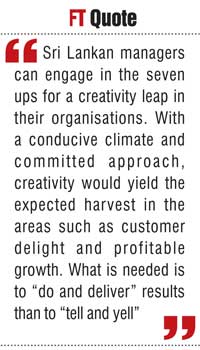Saturday Apr 20, 2024
Saturday Apr 20, 2024
Monday, 29 June 2015 00:00 - - {{hitsCtrl.values.hits}}

Creativity involves breaking patterns and thinking out of the box
Creativity has become a cutting-edge factor for competitive advantage. Even though we have covered it a couple of times, it is well worth revisiting and reinforcing. Sri Lankan managers have to be creative in facing the increasingly-fierce competition. It has become more a necessity than a choice. The focus today is to discuss seven ups for creativity.
Overview
Creativity involves breaking patterns and thinking out of the box. For that to happen, one should know what the “box” is. In other words, one should know the constraints that hinder creativity in moving beyond them. In fact, creative thinking is a mental activity, which produces new ideas or new insights. Innovation is the practical application of it that adds value to an organisation.
In a Harvard Business Review (HBR) article, Tom Kelley and David Kelley question whether the management world is really divided into “creatives” and “noncreatives”? Maybe not, but many people still deem themselves unimaginative. The authors, both leaders at the design and innovation consulting firm IDEO, have discovered that “teaching” creativity is really a matter of helping people find the courage to tap into the “creative confidence” they already possess.
The lesson for us is simple. It is to assess where we stand and move forward accordingly. Peter Drucker advises the managers to be creative and innovative in one of his classic HBR contributions, way back in 1985. “Innovation is the responsibility of every executive, and it begins with a conscious search for opportunities”.
I had the joyful experience of facilitating two sessions on creativity to the executives of a leading local bank last week. It reaffirmed my conviction that Sri Lankan managers can do much better on this front. I would suggest the bundling of the sure-fire path as “seven ups”.
It essentially refers to seven action dimensions. In a nutshell, they are, waking up, shaking up, brushing up, linking up, looking up, growing up, and cheering up. Let’s go into details.
1. Wake up
It simply invites us to be aware of what’s going on. Slowly but surely, modern managers are realising that the complex situations they face cannot be approached in a routine manner. Indeed, the quest for creative solutions has become pervasive. But for creativity to truly add value to an organisation, managers must first understand its purpose and associated priorities.
Albert Einstein said he owes his creativity to listening to Mozart pieces. Certain songs and compositions allow the brain to be more creative and function better. In the present age the concept of music enhancing your thinking has been scientifically researched and proven. Certain frequencies have a positive effect on increasing your brain’s performance and creativity. Today they are known as Binaural Beats and Isochronic Tones.
It is all about awakening to new possibilities, new associations and new connections.

2. Shake up
This is all about challenging the assumptions. One needs to avoid the “quick fix” trap.
Most organisations will acknowledge their need to be more creative, and many will be tempted to pursue the “quick fix” option. Some will, no doubt, claim that they’re satisfied with the degree of success found in the status quo, while failing to realise the long-term benefits of developing a strategy that will ensure an ongoing focus on creativity and innovation to sustain their competitive edge and their very existence. Will your organisation fall into such a trap?
The simple argument here is that conventional thinking will take you only to one point. If you truly want your organisation to make a difference in this world and in the marketplace, then be vigilant in scanning the horizon for new and creative models for doing business. Invite your employees to create new initiatives that provide positive turning points in the lives of consumers and the organisation.
When more attention is given to the untested and untried and less attention is spent on the routine and status quo, this climate can happen. When such creativity is embraced, the key questions become “What’s new? What’s next? What’s better?”
3. Brush up
We need to shape ideas, moving them from raw to ripe state. Brainstorming is one powerful tool for this purpose.
The fundamental requirement is to have a brain and it should be in the proper place. You simply can’t sit on it. Start by suspending your judgment and self-criticism, then start writing down related ideas and possible solutions. The goal is to generate as many ideas as possible in a relatively short span of time. Next, focus on clarifying and refining your ideas in order to arrive at the best possible choice.
It reminds me how gems are found and further shined. Ideas also need to be treated with respect and attention. That is the only way to move forward with innovation and implementation.
4. Link up
“Creativity is just connecting things”, says Steve Jobs. Creative people see connections clearly. They become powerful associations. In fact, creativity acts like the power to connect seemingly unconnected. Using one’s mobile phone to switch on or off the home lights from a faraway location is one such example. Connecting digital technology with drama to create wonderful theatrical experience is another.
Another aspect of linking up ideas is to use humour. In humour the storyteller suddenly places us on the side track and immediately we can see our way back to the starting point. In humour the punch line serves as the bridge between the main track and the side track. Edward de Bono, who advocates “lateral thinking” tells us the parallel. We have to devise a practical means for cutting across the tracks. We can do this by using a combination of provocation and movement.

5. Look up
This is the need for advice and guidance, in a corporate setting. If an employee is not given time or encouragement to be creative and innovative, it can almost certainly be guaranteed that new projects and new mechanisms for their delivery will not be born. Nothing new will happen.
The key word here is encouragement. It depends and hinges on how senior leadership demonstrates their commitment to creativity and innovation. Too often, the atmosphere becomes poisoned by criticism that fosters insecurity, anger and personal agendas with very little consensus building, collaboration or fun. Senior leadership sometimes fails to realise that what they say and do in this context is more powerful than any speech or policy they may make.
Let’s look at it from the point of view of a leader. As a leader, how do you respond to new ideas? What is your reaction to ideas that may not have occurred to you? Are you willing to let other people get the recognition and reward for creativity and innovation? Do you really have a passion for doing the job in new and imaginative ways?
Are you willing to change personally to make this happen? Are you willing to put your neck on the line to protect an employee who shows inventiveness and initiative? Are you willing to obligate funding to support creativity and innovation? Do you prefer to judge ideas rather than encourage them or generate them yourself?
The positive answers to the above will determine the looking up will contribute to creativity.
6. Grow up
Ongoing creative thinking and innovation should be connected into the long term plans. They should be strategically programmed into every meeting in which managers participate. One may ask “How many different ways can we look at this issue or problem?” instead of the proverbial “What have we been taught by someone else regarding how to solve this?”
One needs to define broad parameters in which a team is allowed to operate, and then get out of the way. This, in itself allows for true creativity and innovation rather than a regurgitation of what the team thinks the leader wants. It is a case of “hands off” but “eyes open” approach”.
A team should be empowered to come up with ideas, initiatives and innovations and the leader can constructively assist them to choose the best solution. That is what is happening at Google, 3M and many other such creative organisations.
7. Cheer up
When we enjoy a part of the process, we tend to linger in that stage. According to a 2006 study published in the Proceedings of the National Academy of Sciences, positive moods can increase your ability to think creatively. As the study says, “If you are doing something that requires you be creative or be in a think tank, you want to be in a place with good mood.” Focus on eliminating negative thoughts or self-criticisms that may impair your ability to develop strong creative skills.
In simple terms, ask the question, “What went right?” as opposed to “What went wrong?” As De Bono tells us, creative thinking is not a mystical talent but a skill that can be practiced and nurtured. We need to have positive outlook with a winning mindset.
Way forward
Sri Lankan managers can engage in the seven ups for a creativity leap in their organisations. With a conducive climate and committed approach, creativity would yield the expected harvest in the areas such as customer delight and profitable growth. What is needed is to “do and deliver” results than to “tell and yell”.
(Dr. Ajantha Dharmasiri is the Chairman and Director of the Board of Management of the Postgraduate Institute of Management (PIM). He also serves as an Adjunct Professor in the Division of Management and Entrepreneurship, Price College of Business, University of Oklahoma, USA.)